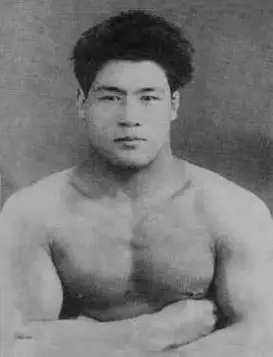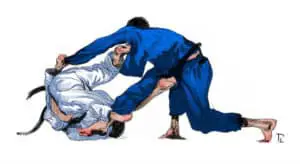Everything You Need To Know About The Kimura Submission!

There are hundreds and hundreds of different submissions in MMA and BJJ but one of the most dangerous and effective submissions is known as the the Kimura. In this article we are going to look at the origins of the Kimura, analyze its effectiveness and show you how to perform it! Let’s get started!
What Is A Kimura Submission?
The Kimura submission is a shoulder lock that places immense stress on the shoulder and forearm. In the Kimura you twist your opponent’s arm behind their back while locking their elbow in place which creates force in opposing directions.
The Kimura lock is a fundamental submission that is popular in MMA, Judo and BJJ. It is very easy to perform, can be difficult to escape and has the potential to cause serious injury.
The Kimura submission also has an interesting story about how it become a must know submission in BJJ. We will look at the story a little later!
Check Out The Video Below To Learn How To Perform The Perfect Kimura
Can A Kimura Lock Break An Arm?
A Kimura lock can break an arm. Due to the opposing forces placed on the arm (the elbow is trapped as you bend the arm backwards) by the Kimura if an opponent does not in time they are likely to suffer a spiral fracture in the arm (humerus).
Who Invented The Kimura Submission?
The Kimura submission was invented by Kano, the creator of Judo. Kano called the submission Ude Garami. However, in BJJ the submission was named after one of Kano’s students, Masahiko Kimura when he used it to defeat Helio Gracie.
The exact inventor of the Kimura submission is unknown as catch wrestlers who call the move the double wrist lock claim to have used the move since the 1800s. And Kano when creating Judo in the late 1800s borrowed from many different grappling arts including wrestling.
As the Kimura is a fairly simple shoulder lock and people have been grappling with each other for thousands and thousands of years it is likely that other athletes have performed the move well before Kano and catch wrestlers.
Kano can be credited for popularizing the move and spreading it across the world. But the Gracies can take credit for modernizing the move and making it a staple submission in every BJJ gym around the globe.
Did Kimura Break Helio’s Arm?
Kimura broke and dislocated Helio Gracie’s arm using a reverse Ude-Garmi (now called a Kimura in BJJ) when they fought in an exhibition match on October, 23, 1951 in Rio de Janiero.

Helio Gracie took on Kimura in a challenge match in Brazil in the early 50s that was billed by the media as Jiu Jitsu vs Judo showdown. The outcome of the match to determine which art was superior!
The match started in flurry of action with Helio Gracie desperately trying to throw Kimura. However, Kimura was easily able to block and counter Gracie’s attack attempts.
Kimura’s plan was to knock Helio unconcious with one of his throws but the Gracies had installed extra padded mats to prevent this from happening.
Once Kimura realized he would not be able to knock Helio without throwing him he began ground fighting with the much smaller Brazilian. He tried a number of different holds which included yoko-sankaku-jime which actually make Gracie pass out but Kimura did not realize and released the hold allowing Gracie to regain consciousness.
During the second Kimura quickly threw Gracie to the ground with an outside reaping throw and immediately pinned Gracie. During Kimura’s kuzure-kami-shiho-gatame Gracie passed out and instinctively tried to push the Japanese Judo champion off him which exposed him. Kimura snatched the arm and performed the famous shoulder lock now known as the Kimura.
Gracie was unable to tap due to being unconcious which led to Kimura twisting the arm over and over again causing a break and dislocation. Helio’s brother finally threw in the towel and Kimura emerged victorious!
Can You Kimura From Mount?
Are you wondering how to finish a Kimura from mount? Then check out this great Kimura mount demonstration by Isaac Olson!
Check out this video on How to do the Kimura from the North South Position by legendary black belt Stephen Kesting!
What Is The Difference Between A Kimura And Americana?
Check Out How To Perform An American Below!
Check Out How To Perform A Kimura Below!
What Does An Americana Submission Do?
The Americana submission places immense pressure on the elbow and shoulder joint. If you do not tap to an Americana you can severely damage your rotator cuff and dislocate your elbow.
The Americana submission is not a lock that should be underestimated! Even though you are likely to learn the Americana on your first day of BJJ this submission can seriously damage your opponent’s shoulder and elbow.
Due to the ability to injure your opponent you should always apply the Americana slowly and gradually. To be a good training partner make sure you give your opponent time to tap!
Is A Key Lock The Same As An Americana?
The Key lock and the Americana are the exact same submission. The key lock was a term used by catch wrestlers in America. While the Americana was a term used by Jiu Jitsu athletes in Brazil who learnt the move from travelling American catch wrestlers.
The term key lock and Americana are interchangeable. The term key lock is often used by old school MMA fighters and catch wrestlers while most modern BJJ athletes use the term Americana. But be rest assured that the submission is the same.
The Gracies who invented Brazilian Jiu Jitsu ran a circus and would often host fighting and wrestling contests. Due to this they would come in contact with different athletes.
One of these travelling wrestlers they met was from America taught them the key lock submission. They then proceeded to call the move the Americana in honor of this unknown American catch wrestler.
Try Out A Kimura Today!
So now you know everything about the Kimura it is time to start cranking some shoulders at tonight’s BJJ practice. Remember you can snatch Kimuras from nearly everything including side control, north south, mount and guard.
The Kimura works best when you catch your opponent by surprise so practice securing that wrist and smoothly establishing your lock. Be careful not to crank the submission to hard. You should apply pressure in a controlled manner otherwise you may hurt your partner’s shoulder. Good luck I hope you score some taps!
